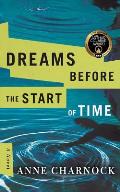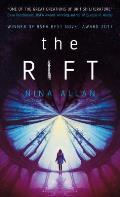Dreams Before the
Start of Time, by Anne Charnock (2017, 47North); and The Rift, by Nina Allan (2017, Titan).
Spoiler Alert...
What makes science fiction a genre? Is it the bells and
whistles, the FTL space ships, the futuristic technology? Is it the ability to
travel in time or across vast regions of space? Does it involve interactions
with alien species, either for the first time or as a matter of course? Or is
it simply because the author or the publisher says so? I will not dignify the
argument put forth by “litr’ary” types that science fiction is an inherently
inferior form of literature. Clearly, they haven’t been reading the superbly
imaginative, elegantly crafted work of the last couple of
decades.
Following the principle of showing instead of telling, I refer
you to the discussions surrounding The
Time Traveler’s Wife (by Audrey Niffenegger, Harcourt, 2003). With due
respect to my colleagues who might disagree, I thought the only people who
considered this novel science fiction were those outside the genre. Yes, the
man of the romantic pair bops about from one time period to another (losing his
clothing along the way), but that did not make it science fiction in my eyes. I
could accept it as romance. The focus, as in Diana Gabaldon’s Outlander, is the (romantic) relationship
between two people. (Although Outlander
involves time travel, very few readers I know would classify it as science
fiction rather than fantasy or romance.) For me, the aspect that put The Time Traveler’s Wife firmly outside
science fiction was the failure to develop the implications of time travel for
society. How has this one man’s ability changed the world? What are the moral and political consequences of his
actions? Why isn’t he found out and his abilities exploited? How can the “fabric”
of time continue linearly with such repeated “tears”?
In other words, science fiction doesn’t just present nifty
ideas in a vacuum – it focuses on how those ideas and gadgets and twists of
fate have larger effects on the natural and human world. Perhaps back in the
age of pulp magazines, a fun gimmick was sufficient to sustain a story with
flimsy plotting, cardboard characters, and mediocre prose, but that hasn’t been
true for a long time now.
This, too, is why I believe Margaret Atwood’s The Handmaid’s Tale falls squarely in
the science fiction genre. Atwood herself refused to consider her dystopian
world as science fiction, calling it instead “speculative fiction.” I think
that’s a distinction without a difference. One
critic (readily identifiable as ignorant of the field by his use of “sci-fi”)
wrote, “Sci-fi sells us fantasies. Margaret Atwood’s classic novel is all about
the danger of fantasy.” To those of us who are actually conversant with science
fiction, the reverse is true, and is a powerful argument for The Handmaid’s Tale belonging on the
same shelf as other brilliantly written feminist dystopian science fiction.
On the other hand, sometimes books like The Time Traveler’s Wife are marketed as science fiction but lack
the thoughtful development of the implications of technology (or time travel)
on society as well as the lives of a few individuals. Dreams Before the Start of Time, by Anne Charnock (2017, 47North)
and The Rift, by Nina Allan (2017,
Titan) fall into this category. Both are beautifully written on a prose level
and both contain “sfnal” elements, yet to my mind, neither is properly science
fiction.
Dreams Before the
Start of Time, by Anne Charnock is a series of related vignettes that
follow, very loosely, a group of people through a generation. The speculative
elements are changes in reproductive technology, beginning with existing current
IVF (in vivo fertilization). External artificial wombs give women the option of
bearing children without physical pregnancy. Other techniques make it possible
for a baby to arise from a single person, male or female, or for two people of
the same sex to have a child that is genetically both of theirs. The characters
use these and other advances, but the technology often seems an afterthought,
one that does not in any significant way impact the relationships between
parents and children or step-children, friends, and couples. Couples still agonize
over giving their children (unborn or born) the best advantages; single parents
cope with stress; children born to single mothers wonder who their fathers are;
sperm donors wonder who their offspring are. How is that new and futuristic? The
sense of wonder or a wonderful or terrifying future is utterly absent. A gay
couple who create a child that is genetically theirs seem in no way different
from one in the present day who adopt a child. Perhaps the author’s point is
that advances in reproductive technology cannot affect basic human
relationships, coming down squarely on the side of biology versus culture. I
find that premise, while worthy, to be insufficient to sustain so many pages,
especially at the cost of examining the interaction of methods that allow
anyone to have a child and burgeoning overpopulation and its effect on
dwindling resources, migration, and so forth.
More than that, Charnock’s future plays almost exactly as our
world now. There are no significant changes in everyday technology, no climate-driven
disasters, no wars or upheavals in government. Tourism abounds; the Earth is a
relatively static place.
Charnock’s prose is effortless and her characters are
beautifully drawn. I think, though, that science fiction readers will find this
collection of vignettes superficial and exasperatingly sedate. Mainstream readers,
on the other hand, may love it if they can be persuaded to overcome the stigma
of the “science fiction” label.
The Rift, by Nina
Allan, is equally beautifully crafted. Both novels show an admirable mastery of
language and nuance. Allan’s work is far more dramatic, as well as possessing a
coherent central story line. Her story centers on the disappearance of a
teenage girl – Julie -- in rural Britain, the emotional and forensic fallout,
the subsequent disintegration of her family, and the alienation of her
surviving sister, Selena. The evidence points to Julie having been the victim
of a serial killer. When Julie contacts Selena decades later, she says she has
been kidnapped by aliens, a humanoid race very like ours but with a different
culture and planetary politics. Parallel story lines follow the initial
investigation, the reunion of the two sisters, and the adventures of Julie on
another world. Of these, I found the legends and histories of the alien people the
most interesting and emotionally involving. “The Mind-Eaters of Pakwa” was chilling
and deeply moving.
As gripping as these mini-stories were, however, the book
kept circling around to the central question: has Julie really been living on
another planet or did she make it all up? And if she did, where has she been?
Why has she contacted her family now, after all this time? Who is telling the
truth, and what are the consequences of shattering recovery from a tragedy that
has defined a family for so long?
Here’s the spoiler: After almost the entire book builds on
the believability of Julie’s story, the rich detail of her adoptive planet, and
the slow rebuilding of trust between the sisters, the revelation at the end hit
me as a total disappointment. The discovery of Julie’s decomposed remains,
right where she had disappeared, provide conclusive DNA proof that she died
years ago. I wanted to throw the book across the room. Who’s been masquerading
as her, well enough to convince Selena (and their mother)? And for what cruel
reason? Or is all of this a delusion on the part of Selena, who has given every
indication of being a rational person up until now? Maybe an author can get
away with such a contradictory ending in mainstream, but science fiction
readers demand a higher standard of logic, not to mention clarity. It’s right
up there with “And it was all a dream” or “Fooled you!” type endings. Therefore,
despite the intriguing possibility that Julie actually traveled through a
dimensional portal to another world, and that world is as vivid and troubled as
our own, the cop-out ending kicked this novel out of the sfnal sphere for me.
Which made me sad because I really did love that other world and its people.
There’s another possible ending, tacked on at the end
without any previous suggestion, that Julie is an alien from that other world:
If she never called Julie again, no one would blame her. The DNA test said her sister was dead, she had Schechter’s paperwork to prove it. So what was wrong, then, what was wrong?
Her sister was alone on an alien planet, and she had no one.
No one but me. So what if she isn’t the same as she was when she went missing? What difference does it make?
Whoever the hell she is, she’s still my sister.
That would have been an incredibly cool story. But it isn’t
the one I read.


No comments:
Post a Comment